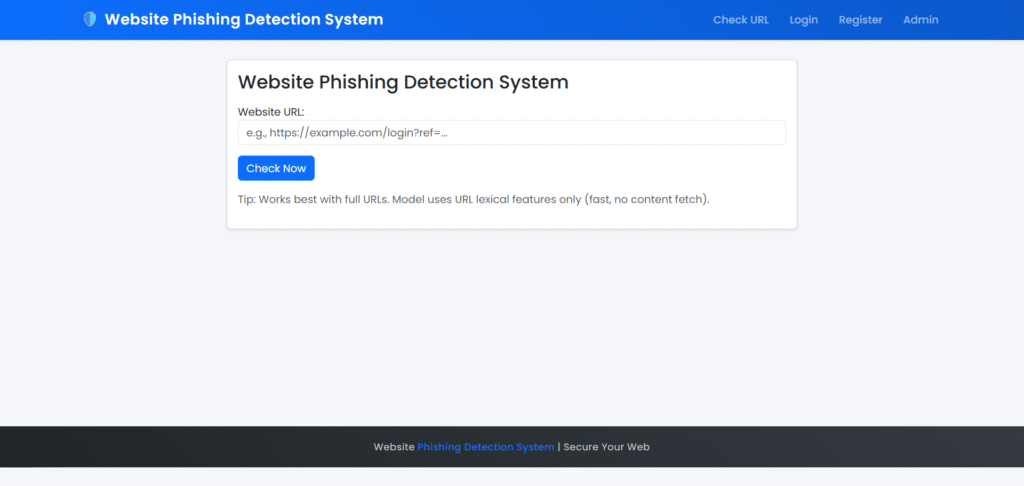“WEBSITE PHISHING DETECTION SYSTEM” is a web-based application which is aim to address phishing attacks by combining machine learning techniques with a Django-based web platform. Phishing is a fraudulent attempt to obtain sensitive information such as usernames, passwords, and banking details by disguising a malicious website as a legitimate one. Millions of users fall victim to phishing attacks every year, leading to significant financial loss, identity theft, and security breaches.
By combining the strengths of machine learning, web development, and cybersecurity, this project provides a practical solution to one of the most pressing challenges of the digital world. It not only raises awareness among users but also equips them with a tool to stay protected against phishing attacks in real time.
 Tech Stack Used
Tech Stack Used
 Frontend / Web Interface:
Frontend / Web Interface:
- Django (Python Web Framework) – Used to create the web interface for user input, displaying predictions, and managing data
- HTML5, CSS3, JavaScript – For rendering and styling web pages
- Bootstrap (optional) – For responsive UI components
- Django Templates – For dynamic web page rendering
 Machine Learning / Backend Logic:
Machine Learning / Backend Logic:
- scikit-learn – Machine Learning library used to implement algorithms like Logistic Regression, Decision Tree, Random Forest, KNN
- NumPy – For numerical operations and matrix manipulation
- Pandas – For handling and preprocessing datasets
- joblib – To save and load the trained machine learning model
- tldextract – Identify suspicious subdomains (like
paypal.com.fake-site.co.in)
 Database:
Database:
- SQLite – Lightweight relational database used to store user data and predictions
- Django ORM (Object Relational Mapper) – Handles interaction between Django models and the SQLite database
 Tools & Environment:
Tools & Environment:
- Python 3.x – Core programming language used
- PyCharm – IDE for development
- Virtualenv / pip – For managing dependencies
Key Features of the Proposed System
- User-Friendly Interface:
A web-based platform where users can input website URLs easily and receive instant feedback. - Real-Time URL Analysis:
The system examines different features of the URL (length, special characters, domain age, IP-based URLs, suspicious keywords, etc.) to determine if it is genuine or phishing. - Machine Learning Model:
A trained ML model classifies the URLs into legitimate or phishing based on extracted attributes. - Database Support:
Stores the results of checked URLs for historical analysis and tracking user activity. - Admin Dashboard:
Provides system administrators with the ability to monitor usage, manage users, and analyze detection reports. - Security Alerts:
Displays alerts and notifications to warn users when a malicious or phishing URL is detected. - Responsive Design:
Built using Bootstrap for cross-device compatibility, making the system accessible on desktops, tablets, and smartphones.
Website Phishing Detection System: Output Screens
Home Page

User Registration

User Login

Checked URL History

Admin Dashboard

Registered User

How to run the Website Phishing Detection System Python ML Project
1. Download the zip file
2. Extract the file, copy phishguard, the folder and paste it on the desktop
3. Open PyCharm and import the project into PyCharm
4. Install five libraries (if not installed)
pip install joblib pip install numpy pip install scikit-learn pip install pandas pip install tldextract
5. Run the Project using the following command
python manage.py runserver
Now, click the URL http://127.0.0.1:800,0 and the Project will run
Login Details
*************admin************
Username: admin
Password: Test@123
*************User************
Username: john12
Password: Test@123
Or Register a new user.
Website Phishing Detection System: Project Demo
Website Phishing Detection System: Project, Report and PPT
The post Website Phishing Detection System using Python & Machine Learning appeared first on PHPGurukul.
Source: Read MoreÂ
